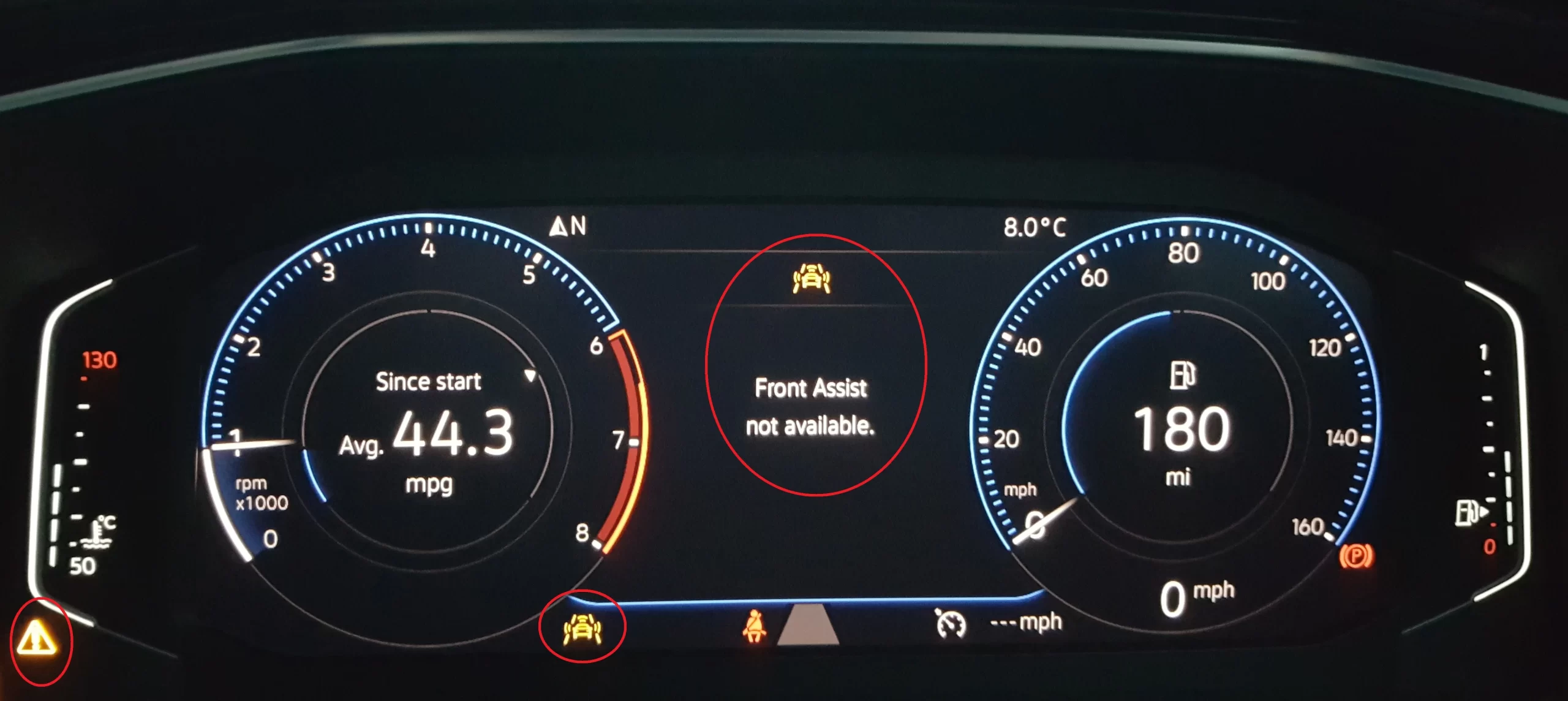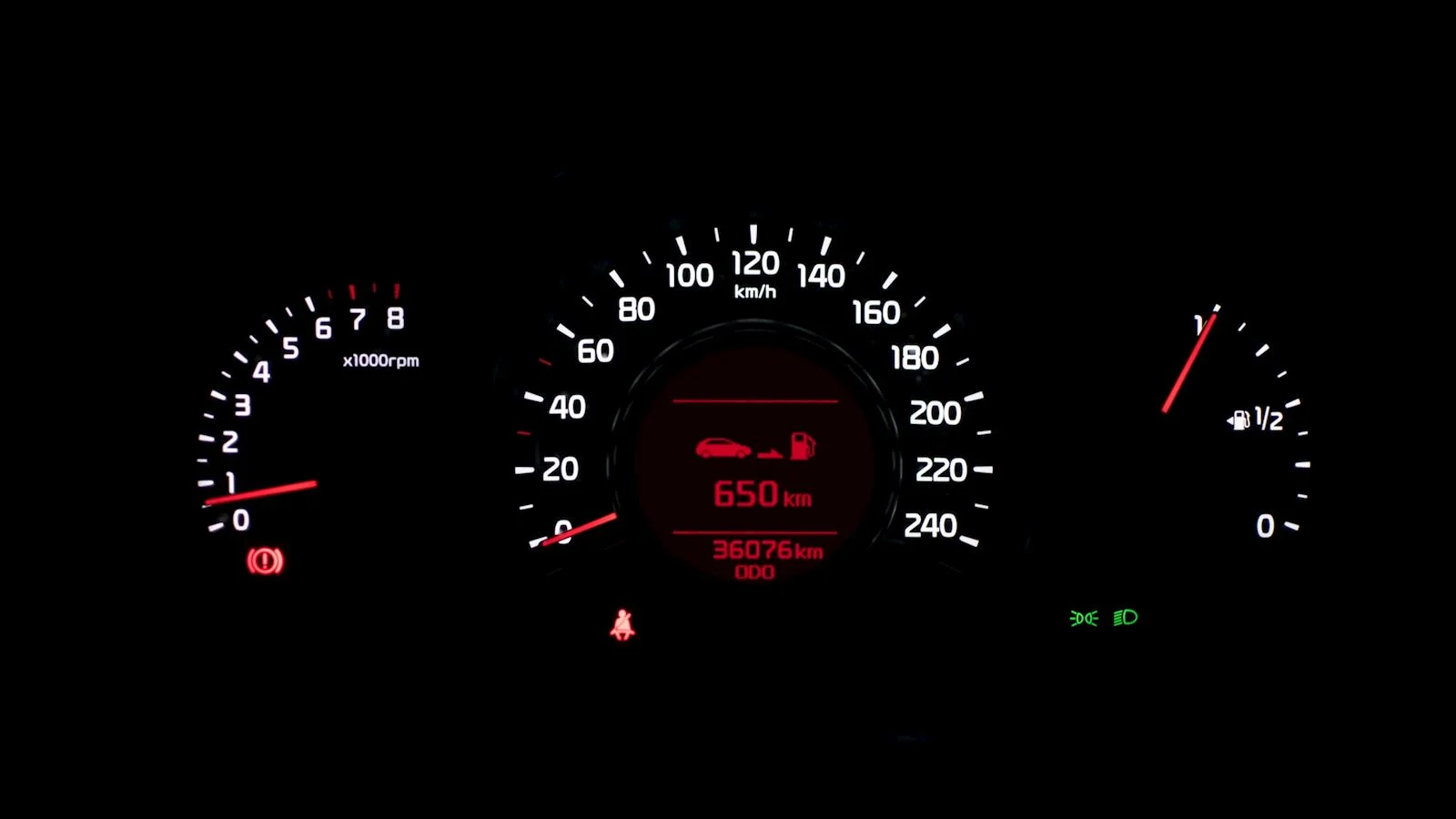If you’re a car owner, you might have come across the message “Front Assist Not Available” on your dashboard.
This warning can be quite alarming, especially if you’re not sure what it means.
The front assist system is an ultra-sophisticated safety feature that helps maintain a safe distance between vehicles and prevents crashes from ahead.
However, it doesn’t always work well.
In this article, we’ll explore the top 7 causes and solutions for why front assist is not available in your car.
We’ll also discuss how to fix it and what you can do to prevent it from happening in the future.
Let’s dive in!
What Is Front Assist Not Available?
“Front Assist Not Available” typically refers to a safety feature in a vehicle called Front Assist, which is also known as forward collision warning or automatic emergency braking.
Front Assist is designed to monitor the road ahead and provide warnings or take automatic actions if a potential collision with another vehicle or obstacle is detected.
If your vehicle displays a message or warning saying “Front Assist Not Available,” it suggests that there may be an issue or malfunction with the Front Assist system.
What are the top 7 causes of Front Assist Not Available?

If you see the message “Front Assist Not Available” on your dashboard, it means that the front assist system is not functioning properly. There could be several reasons why this is happening, including a dirty radar sensor, low battery, faulty brake light switch, faulty spiral cable, faulty fuse or relay, or an error with the control switch.
1: Dirty Radar Sensor
The issue stems from a soiled radar sensor, a critical component responsible for object detection and distance calculation between the vehicle and obstacles.
The accumulation of dirt, rocks, sand, debris, moisture, or other contaminants adversely affects the sensor’s performance.
This buildup can cause dents in the sensor layer, leading to erratic behavior or a complete failure of the front radar system.
The compromised functionality poses a risk, as the vehicle may struggle to accurately detect and respond to obstacles, potentially compromising safety features reliant on the radar sensor.
The problem requires attention and resolution to restore the proper functioning of the front radar.
2: Low Battery
The front assist system may malfunction due to a shortage of battery power. Symptoms of a low battery include corrosion at the terminals and bulging or leaking of the case.
When the battery lacks sufficient power, it can compromise the proper functioning of the front assist system.
Terminal corrosion may hinder electrical connections, while bulging or leaking indicates potential damage to the battery, affecting its ability to supply the necessary power.
3: Faulty Brake Light Switch
A glitch in the brake light switch, tasked with illuminating brake lights upon pedal pressure, poses a unique threat to the front assist system.
When the switch becomes immobilized or succumbs to burnout, it triggers a halt in the front assist system’s operation. This glitch isn’t just a dimmed brake light issue; it directly sabotages the safety apparatus.
The switch’s pivotal role in signaling braking actions means a compromised switch jeopardizes the entire front assist system.
An unresponsive switch threatens not only visibility but also disrupts the synergy between braking alerts and collision avoidance, making addressing this brake light switch anomaly paramount for road safety.
4: Faulty Spiral Cable
The spiral cable plays a crucial role by transmitting signals from the steering wheel to the car’s computer in a unique and essential manner.
A fault or open circuit within this cable disrupts not just data transmission but the very heartbeat of the front assist system. Picture it as the maestro losing connection with the orchestra – chaos reigns.
This glitch isn’t a mere technological hiccup; it’s a disruption in the seamless dance of communication.
The faulty spiral cable jeopardizes the precision of steering-related signals crucial for the front assist system, underscoring the imperative to address this anomaly for the symphony of safety features to harmonize flawlessly.
5: Fuse or Relay Faulty
In the intricate dance of car technology, a flawed fuse or relay takes the spotlight, disrupting the harmony of the front assist system. These power providers, crucial for the system’s function, become saboteurs when faulty.
It’s not just an electrical glitch; it’s a disruption in the power flow narrative, halting the performance of safety features. This malfunction urges attention, calling for a seamless automotive dance where power effortlessly courses through the veins of the front assist system.
6: Error Due to Control Switch
In the safety lineup of your vehicle, the control switch plays a crucial role in turning the front assist system on and off. But when this switch acts up—has an error—it messes with the system’s smooth operation.
Imagine it as a simple routine gone awry. The control switch, in charge of making the system work or not, falters, making the front assist system less reliable. It’s not just a glitch; it’s a hiccup that needs fixing for the safety features to work seamlessly.
Picture the control switch as the director, and we want it to lead the show without any missteps for a safer ride.
7: Software Update Required
The front assist system relies on regularly updated software. An outdated software version might lead to the system ceasing to function. Keep in mind that like any well-maintained tool, the front assist system deserves the latest software to ensure it operates at its best.
So, don’t overlook the importance of timely software updates to keep your system running smoothly and efficiently. It’s akin to providing your vehicle with the latest tools it needs to navigate the road safely. Stay ahead with those updates for a consistently reliable front assist system.
What Are the Solutions of Front Assist Not Available?

Here are some general steps you can take to address this issue:
-
Check the Owner’s Manual
Consult your vehicle’s owner’s manual for specific information about the Front Assist system, including any troubleshooting steps and potential causes for the “Front Assist Not Available” message.
-
Restart the Vehicle
Sometimes, electronic systems can experience glitches. Try turning off the ignition, waiting for a few minutes, and then restarting the vehicle to see if the issue persists.
-
Check for Obstructions
Ensure that the sensors and cameras used by the Front Assist system are not obstructed by dirt, snow, or other debris. Clean the sensors and cameras if necessary.
-
Verify System Activation
Make sure that the Front Assist system is activated. Some vehicles allow drivers to enable or disable certain safety features. Check the settings menu or refer to the owner’s manual to confirm that Front Assist is turned on.
-
Address Faulty Sensors
If there is a sensor issue, it may need to be inspected and potentially replaced by a qualified service technician. Faulty sensors can lead to false readings or the deactivation of safety features.
-
Check for System Updates
Manufacturers occasionally release software updates to improve the performance and reliability of vehicle systems. Check with the vehicle manufacturer or the dealership to see if there are any available updates for the Front Assist system.
-
Visit a Dealership or Service Center
If the issue persists or if you are unable to identify the cause, it’s advisable to take the vehicle to an authorized dealership or service center. Qualified technicians can perform a diagnostic check to identify and address the specific problem.
NOTE: If you are looking for problems and solutions for front assist not available volkswagen, front assist not available skoda, front assist not available vw atlas, and
front assist not available vw jetta, the reasons and solutions we have shared above can help you a great deal.
What does Front Assist Not Available No Sensor View Mean?
If the dashboard displays the alert “Front Assist Unavailable – No Sensor View,” it indicates a malfunction in the proper functioning of the front assist system.
This error typically arises due to the presence of contaminants on the radar sensor or an obstruction obstructing the sensor’s view.
The radar sensor plays a pivotal role in identifying objects and determining the distance between the vehicle and potential obstacles.
The accumulation of dirt, rocks, sand, debris, moisture, or other elements can compromise the sensor’s integrity, leading to erratic behavior or a complete malfunction of the front radar.
To address this issue, examine the front bumper to ensure there are no objects obstructing the radar or directly in front of the sensor.
Additionally, consider cleaning the sensor to restore the system’s optimal functionality.
What Does ACC and Front Assist Not Available Mean?
If you encounter the message “ACC and Front Assist Not Available,” it indicates a potential issue with the Adaptive Cruise Control (ACC) and Front Assist systems in your vehicle.
This error could stem from various causes, including sensor malfunctions or calibration issues.
To resolve this issue, start by ensuring the sensors, particularly the radar sensor, are free from obstructions and debris.
Clean the sensors meticulously, and if the problem persists, consider restarting your vehicle.
If the error persists, consulting with a qualified service technician or contacting the dealership is advisable.
They can conduct a thorough diagnostic check, address any underlying problems with the ACC and Front Assist systems, and perform necessary recalibrations to restore these safety features to optimal functionality.
Where is the front assist sensor located?
The location of the Front Assist sensor can vary depending on the make and model of the vehicle, as well as the specific technology used by the manufacturer. However, in many cases, the Front Assist sensor is typically located behind the front grille or within the emblem area on the front of the vehicle.
The Front Assist system often uses radar sensors and/or cameras to monitor the road ahead for potential collisions. The radar sensor emits signals and receives reflections, allowing it to detect objects and calculate the distance to them. If the sensor becomes obstructed or dirty, it may lead to issues with the Front Assist system and trigger warning messages.
To find the precise location of the Front Assist sensor in your vehicle, it’s best to refer to the owner’s manual provided by the manufacturer. The manual usually contains detailed information and diagrams specific to your car model, guiding you to the location of the Front Assist sensor and providing instructions on how to clean or maintain it. If you’re unable to locate this information in the manual, you may also contact the vehicle manufacturer’s customer service or visit an authorized dealership for assistance.
What is the warning on the front assist?
The warning messages related to Front Assist may vary slightly among different vehicle manufacturers and models. However, a common warning message associated with Front Assist issues is typically displayed on the vehicle’s dashboard or instrument cluster. The warning message often indicates that the Front Assist system is not available or is experiencing a malfunction. Examples of warning messages related to Front Assist issues include:
- “Front Assist Not Available”
- “Front Assist Malfunction”
- “ACC and Front Assist Not Available”
- “Front Assist Sensor Blocked”
- “Front Assist System Error”
These warnings are designed to alert the driver that the Front Assist system, which includes features like Forward Collision Warning and Autonomous Emergency Braking, may not be operating correctly. When such warnings appear, it is essential for the driver to address the issue promptly, as it may impact the proper functioning of safety features designed to prevent or mitigate collisions.
Important: ABS Traction Control and Hill Assist Light On: Your Vehicle’s Warning Signals—What Do They Reveal?
Can you turn off front assist?
In many vehicles equipped with Front Assist or similar safety systems, there is often an option for the driver to manually disable or turn off the Front Assist feature. However, keep in mind that turning off safety features may leave the vehicle without certain collision-avoidance capabilities.
The method to turn off Front Assist can vary by vehicle make and model, and it’s typically outlined in the owner’s manual. Here are general steps that you might follow:
-
Check Vehicle Settings
Look through the settings menu on your vehicle’s dashboard or infotainment system. There may be an option related to driver assistance features where you can find the Front Assist or Forward Collision Warning settings.
-
Use the Control Buttons
Some vehicles have dedicated buttons or controls on the steering wheel or center console that allow you to access and adjust driver assistance settings. Check if there is a button labeled “Driver Assistance,” “Front Assist,” or similar.
-
Refer to the Owner’s Manual
The most accurate instructions for your specific vehicle will be found in the owner’s manual. Look for a section on driver assistance features, and it should provide guidance on how to disable Front Assist.
It’s important to note that turning off safety features should be done with caution, as these systems are designed to enhance driver and passenger safety. If you decide to disable Front Assist temporarily, consider reactivating it once the specific situation that prompted the manual deactivation has passed.
How do you clean a radar sensor? – Step by Step
Cleaning a radar sensor is a straightforward process, but it requires care to avoid damaging the sensor. Here are general steps to clean a radar sensor:
-
Identify the Sensor Location:
Refer to your vehicle’s owner’s manual to locate the radar sensor. It’s typically located behind the front grille or within the emblem area on the front of the vehicle.
-
Turn Off the Vehicle:
Ensure the vehicle is turned off before you start the cleaning process. This helps to prevent any accidental activation of safety features during cleaning.
-
Remove Debris:
Gently remove any visible debris, such as dirt, leaves, or twigs, from the sensor area using a soft brush or your hands. Be careful not to scratch or damage the sensor.
-
Clean with a Soft Cloth:
Dampen a soft, lint-free cloth with water. Ensure the cloth is not too wet to avoid water entering the sensor. Gently wipe the sensor surface to remove dirt or residue. If necessary, you can use a mild, non-abrasive glass cleaner on the cloth.
-
Air Dry or Use Compressed Air:
Allow the sensor to air dry or use a can of compressed air to blow away any remaining moisture. Ensure the sensor is completely dry before restarting the vehicle.
-
Avoid Harsh Chemicals and Abrasives:
Do not use harsh chemicals, solvents, or abrasive materials, as they can damage the sensor. Stick to mild cleaning solutions and soft materials.
-
Check for Proper Functionality:
After cleaning, start the vehicle and check for any warning messages related to the Front Assist system. Ensure that the system is functioning correctly, and there are no issues with the radar sensor.
Conclusion
The front assist system is an ultra-sophisticated safety feature that helps maintain a safe distance between vehicles and prevents crashes from ahead.
However, it doesn’t always work well.
If you see the message “Front Assist Not Available” on your dashboard, it means that the front assist system is not functioning properly.
There could be several reasons why this is happening, including a dirty radar sensor, low battery, faulty brake light switch, faulty spiral cable, faulty fuse or relay, or an error with the control switch.
In this article, we’ve explored each of these causes in detail and discussed how to fix them.
We hope that this article has been helpful in providing you with the information you need to keep your front assist system in top condition.
Drive safe!




